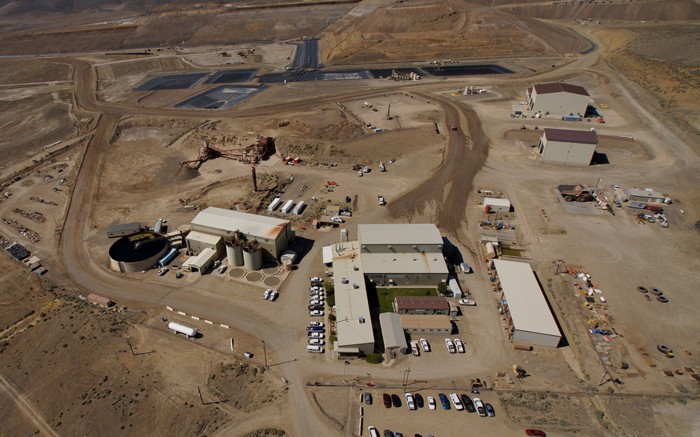VANCOUVER — With a $275-million deal to buy the Marigold gold mine in Nevada, Silver Standard Resources (TSX: SSO; NASDAQ: SSRI) will be doubling its production profile, boosting its reserves by 50% and lowering its geopolitical risk.
The all-cash acquisition will see the Marigold mine become a cornerstone operation for mid-sized Silver Standard, after years as a small mine under 67-33 joint-owners Goldcorp (TSX: G; NYSE: GG) and Barrick Gold (TSX: ABX; NYSE: ABX).
Located in Humboldt County, Nev., near the northern end of the Battle Mountain–Eureka trend, Marigold has been in operation since 1988. An open-pit, heap-leach operation, Marigold processes 40,000 tonnes of ore daily, and produced 162,000 oz. gold in 2013. Marigold’s reserves have grown over the last five years to stand at 294.5 million proven and probable tonnes grading 0.52 gram gold per tonne, for 4.9 million oz. gold.
“Adding Marigold to our portfolio transforms Silver Standard into a multi-mine producer and immediately doubles our silver production, plus we retain our financial capacity to finance future growth, all with no share issuance,” said Silver Standard president and CEO John Smith in a conference call. “We are here to build a truly excellent company, and I believe this transaction will be looked back on as a pivotal moment in Silver Standard’s history.”
Marigold has produced more than 140,000 oz. gold a year, but high per-ounce costs of late led many observers to downplay the operation’s significance. Smith says costs rose because Goldcorp and Barrick spent $150 million at Marigold in 2012 and 2013 on larger mine equipment, while capitalizing stripping and capitalized exploration. Silver Standard expects that investment will pay off.
“Marigold’s perception as a high-cost mine is one of the reasons we like the asset,” Smith said. “When the industry moved to report all-in sustaining costs, that was positive, but it somewhat distorted places like Marigold where the owners invested significantly over the last few years.”
Smith said Marigold’s all-in sustaining costs in recent years sat near US$1,550 per oz. The mine’s cash costs, however, averaged US$880 per oz. Capital costs accounted for the other US$670 per oz., an amount that Smith expects to decline by at least two-thirds going forward, with the necessary investments now complete.
Silver Standard plans to update the reserve and resource estimates for Marigold in the third quarter, followed by an optimized mine plan in the fourth quarter. In developing its Marigold plan, Smith says the company will focus on “cost and quality, not quantity.”
As the name implies, Silver Standard has to date been a primary silver producer. Its operating mine, Pirquitas, is one of the largest silver mines in the world. Marigold is a gold operation, but Smith says the shift from silver to gold was not the primary driver of the deal.
“Pirquitas and Marigold are both precious-metal mines, so adding Marigold improves our country risk while maintaining our leverage to the precious-metal market,” Smith said. “This acquisition is one about geopolitical risk and cash flow and opportunity, rather than one about silver versus gold.”
Based on Marigold’s production numbers from 2013, Silver Standard expects to produce 17.9 million equivalent oz. silver in 2014, up from a pre-Marigold guidance of 8.3 million oz.
The addition of Marigold means 34% of the company’s silver equivalent reserve ounces would now be in the U.S., with 54% in Mexico and the rest in Argentina and Peru. Before the Marigold deal, 82% of the company’s reserves were in Mexico.
With a new mine soon to be on the books and the sale of its exploration-stage San Agustin project to Argonaut Gold (TSX: AR; US-OTC: ARNGF) now closed, an analyst on the conference call asked Smith if Silver Standard was finished rejigging its portfolio. The answer was no.
“We have a lot of organic growth within the portfolio now, but we have retained the capacity to buy as well,” Smith said. “We’ll stay active around buying and selling.”
Silver Standard had US$401.4 million in the bank at the end of September, but that number has grown since it closed the US$75-million San Agustin sale.
In 2014 the company plans to spend US$15 million at Pirquitas, including a US$6-million tailings facility expansion, and US$22 million on exploration and development at other projects.
The Pirquitas silver mine in Argentina has been in production for four years.
In 2013 Pirquitas produced 8.2 million oz. silver. It is expected to churn out a similar amount of silver this year, at an average cash cost of US$13 per oz. sold.
The company has two development-stage projects: Pitarrilla is a large-scale silver–lead–zinc project in Durango state, where Silver Standard is looking for ways to lower the $741-million capital cost estimate; San Luis is a small-scale silver project in Peru. The company has another seven exploration-stage projects across the Americas.
For Goldcorp, which owned 66.7% of Marigold, and Barrick, which owned the rest of the mine, the divestment fits both companies’ efforts to streamline their portfolios and focus on large, low-cost assets.
On news of the Marigold deal Silver Standard’s share price lost 16¢ to close at $8.39. The company has a 52-week share price range of $5.38 to $12.27, and 80.8 million shares outstanding.


Be the first to comment on "Silver Standard buys Marigold mine for $275M"